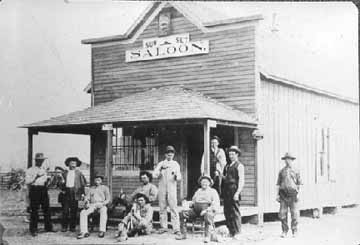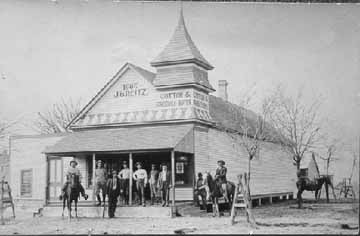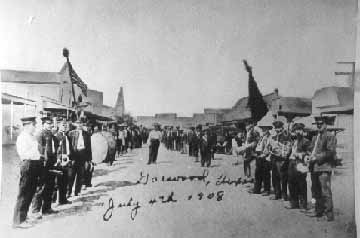



COLORADO COUNTY, TEXAS
Garwood in the Colorado County Sesquicentennial Commemorative Book
Take a look at Garwood, Texas at TexasEscapes.com
Bucksnag Hunting Club includes early pictures and history of Garwood
See Garwood at the Handbook of Texas Online
Garwood W. C. T. U. Cookbook extracts
| Halletsville Herald: A gentleman who came in from Rock Island Tuesday says that a large part of that place has been moved over to a new town called Red Bluff on the Colorado river, where the big pumps for irrigating and the big rice farms are situated. He says that many who bought lots from the Rock Island town company are greatly displeased about the removal, as it has greatly depreciated the value of their property. Weimar Mercury, May 11, 1901, page 3Eagle Lake Advertiser: The Cane Belt railway company a few weeks ago purchased the spur running through Captain Dunovant’s plantations, some four or five mile of track. The company contemplates building to Red Bluff in the near future, we understand. If this line is built this town will gain another mail train, which will add materially to the business interests of the city. Weimar Mercury, May 11, 1901, page 3TWO NEW TOWNS BUILDINGColumbus, Tex., May 12.--The rice Industry In Colorado county has created two new towns. Lakeside . . . The second town is Garwood, named for ex-Senator Garwood, formerly of Bastrop, now of La Grange. This town is now being built on a high prairie on the west bank of the Colorado river, about twenty miles south of Columbus at a point heretofore known as Red Bluff, now owned by Hon. M. H. Townsend, W. T. Burford and T. F. Bouldin of Columbus, and T. A. Hill, of Weimar. The townsite was laid off two months since and the streets properly graded., An attractive postoffice building is finished and some ten or twelve houses, dwellings and stores are completed and others in course of erection. One of the requirements of the townsite company is that only creditable, substantial houses shall be built, and all shall be painted. A large pumping plant is nearing completion on the bluff over the river and nearly three miles of canal, most of which is 100 feet wide, is constructed. The Red Bluff Rice company, composed of the above named gentlemen, is planting 1000 acres in rice for this season. A gradual descending grade of the land from this point south to the bays skirting the Gulf of Mexico affords the possibility of extended irrigation for rice in this direction and it is the intention of the company to extend their canal and irrigate more land year after year. The county has just completed a steel truss bridge across the river at Garwood, thus connecting two of the most fertile and prosperous sections of the county. The nearest railway station is Matthews on the Cane Belt railroad, about five miles distant and every effort will be made to induce the Cane Belt company to extend a branch line to Garwood, with good reasons to hope they will do so. The soil in that section is rich, black, pulverable, holding water admirably, but not so sticky as to prevent easy cultivation. There are at present three steam gins in the neighborhood, which usually ginned from 3000 to 3500 bales of cotton annually before the boll weevil visited this section. The Red Bluff Rice company’s proposition is decidedly promising and in the near future their town as a business place, will doubtless develop into considerable importance. Weimar Mercury, May 25, 1901, page 6News from AltairWe learn that one car of brick has arrived for the big rice warehouse to be built by the Red Bluff rice people at Garwood. Weimar Mercury, June 14, 1902Dr. Kent Operates On Seven Cases TrachomaDr. Frank Kent of San Antonio made a special trip to Weimar Wednesday to operate on the seven children of E. D. Lobpreis[sic] of Garwood for trachoma, a contagious infectious eye disease affecting the eye lids. Dr. Kent stated the cases were discovered by the county health nurse and excluded from school by the county health officer. Any foreigner suffering from trachoma is not permitted to enter the Untied States, and it is the vigilance of federal medical inspectors that is responsible for the small number of cases among our school children, being estimated at about 10 per cent. Dr. Kent stated that 17 out of each 100 inmates in the blind institute are due to complications following trachoma. The disease is easily cured in the early stages. Dr. Kent recalls that during his post-graduate studies in New York in 1902 that trachoma was so prevalent it was necessary to establish a hospital staff of physicians and nurses to treat them, as 35 to 40 per cent of the school children were infected. Dr. Kent was assisted by our local physician, Dr. C. G. Cook. Weimar Mercury, January 20, 1928 |
Garwood State Bank Looted By Lone Bandit Early Last MondayCashier Chapman Forced Into Waiting Car and Carried to Matthews By Man Who “Needed Money” A lone bandit held up the Garwood State Bank, kidnapped the cashier and escaped with $4100 shortly after the bank opened Monday. The robber left $4 in nickels and pennies in the safe. The robber went about the job leisurely, going first to a nearby confectionery, where he drank a “coke.” Then he parked his car about 30 yards to the side of the bank and entered the front door. Going to the cashier’s window, the bandit asked the cashier, J. L. Chapman, if he knew Ben Wilson. Chapman replied that he had never heard of the man. The robber then asked Chapman if he knew Dave Lundquist. “Certainly, I know him,” replied Chapman. “He is a rice farmer.” Chapman said the man then drew a pistol and at the same time jerked a money sack from his pocket and ordered Chapman and Mrs. Cole Hopkins, assistant cashier, to “fill it up and make it snappy.” The robber ordered Mrs. Hopkins to go into the vault and put the money in the sack. She loaded the money in, including both silver and currency, and handed the sack to the bandit who then forced Chapman to help him carry it to the car, ordering Mrs. Hopkins to “Stay in that back room until I get away.” Chapman was forced to get into the car, a blue Chevrolet coupe, 1932 model, with a Colorado County license, and the bandit roared out of town toward Eagle Lake. When about seven miles out, near Matthews, Chapman was released and the bandit turned toward Calhoun. Chapman went on into Eagle Lake and got a ride back to Garwood. Chapman said the man talked little during the ride. He said, however, that he knew “this thing is wrong but I have a wife and children who are starving. I had to do it.” Chapman quoted him. In he meantime, Mrs. Hopkins, who left the back room when she heard the car start, spread the alarm and a posse of officers and citizens hurriedly was formed and gave chase but was unable to catch up with the bandit. While there was only one man in the car until Chapman was released, persons working in the river bottom reported seeing two men in the car of the exact description of the bandit’s auto, which turned into Highway 3, the Old Spanish Trail, about half way between Eagle Lake and Columbus, 20 miles from Garwood, an hour or so after the robbery. Showed a picture of Clyde Barrow, notorious outlaw, Chapman said positively there was no resemblance to the bank bandit. An arrest was made at Sheridan last Monday night, Sheriff Hoegemeyer taking into custody a man named Livergood in connection with the robbery. In the party making the arrest were Sheriff Hoegemeyer, deputy Townsend, Ashley Walker and Justice Max Conner of Eagle Lake and Sheriff Will Loessin and Deputy Jim Flournoy of LaGrange. The house was surrounded before entrance was attempted. The man was in bed, the time being about eleven o’clock. He submitted to arrest without resistance and was taken to Garwood, thence to this city where he was lodged in jail. Livergood was taken to Garwood yesterday and shown to several prominent citizens who had seen the perpetrator of the robbery at the time the act was committed and he was positively identified by several business men, including Cashier Chapman and Assistant Cashier Mrs. Hopkins. Examining trial will be held in Judge Griffitt’s court at Garwood Saturday morning at ten o’clock. The accused, L. J. Livergood does not have a car, and the Chevrolet coupe used in the escape is being sought out. The car bore a Colorado County number, beginning with 188 thousand. No trace of the stolen money has been located. Livergood is said to have a prison record. The board of directors of the Garwood State Bank met yesterday and elected George Herder, Jr. as a member of the board to fill the vacancy caused by his father’s death, and elected him to the presidency of the bank. Papers were being filled out and executed for the insurance on the amount of the loss through the robbery which amounted to $4262.27. It is expected that the bank will be reimbursed for this loss within a few days. Colorado County Citizen, May 3, 1934
|
WORK BEGINS ON NEW COLORADO BRIDGE
|

